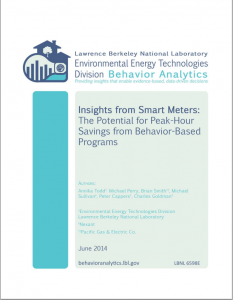Full Title: Insights from Smart Meters: The Potential for Peak-Hour Savings from Behavior-Based Programs
Author(s): Todd, Annika, Michael Perry, Brian Smith, Michael J. Sullivan, Peter Cappers, and Charles A. Goldman
Publisher(s): Lawrence Berkeley National Lab
Publication Date: June 1, 2014
Full Text: Download Resource
Description (excerpt):
The rollout of smart meters in the last several years has opened up new forms of previously unavailable energy data. Many utilities are now able in real-time to capture granular, household level interval usage data at very high-frequency levels for a large proportion of their residential and small commercial customer population. This can be linked to other time and locationspecific information, providing vast, constantly growing streams of rich data (sometimes referred to by the recently popular buzz word, “big data”). Within the energy industry there is increasing interest in tapping into the opportunities that these data can provide.
The richness and granularity of these data enable many types of creative and cutting-edge analytics. Technically sophisticated and rigorous statistical techniques can be used to pull interesting insights out of this highfrequency, human-focused data. We at LBNL are calling this “behavior analytics”. This kind of analytics has the potential to provide tremendous value to a wide range of energy programs. For example, highly disaggregated and heterogeneous information about actual energy use would allow energy efficiency (EE) and/or demand response (DR) program implementers to target specific programs to specific households; would enable evaluation, measurement and verification (EM&V) of energy efficiency programs to be performed on a much shorter time horizon than was previously possible; and would provide better insights in to the energy and peak hour savings associated with specifics types of EE and DR programs (e.g., behavior-based (BB) programs).
